► The story of the Hertz Jota #12 car
► An accident in FP2 looked to have ended things
► How the team made it to the finish
This year’s Le Mans offered 24 hours of nail-biting racing, with Toyota, Ferrari and Porsche all in the hunt until the very last lap. Ferrari ultimately took the overall honours, but for the Hertz Jota team’s #12 Porsche 963, even taking the tricolour flag to start the race was a victory. A seemingly innocuous crash at the end of practice meant the team had just 24 hours to salvage and rebuild its race car – a process that’d usually take weeks. Here’s their inside story of the race before the race.
11:57 Weds: accident at the end of FP2
‘So the accident happened literally midnight on Wednesday night,’ the Jota team’s co-owner Sam Hignett tells us at around 10am in the team’s hospitality space. The race is just over halfway run, but at least one half of the Jota team have already had more than one Le Mans’ worth of pressure.
At first glance, Callum Ilott’s bump looked bad but fixable. The young Englishman had overcorrected in the famous Esses between Dunlop and Tertre Rouge and hit the barrier – ripping the front of his 963 off in the process. It was a relatively easy mistake to make in such slippery conditions and in such poor light – but the punishment didn’t match the crime.
‘I over-corrected my trajectory after a slight loss of control and hit the wall,’ said Illot after the crash. ‘At first, we thought the car was fine, but after further checks, the chassis had been affected. We had to change it.’
01:00 Thurs: Back in the garage
‘So the first thing was to get the chassis back and inspect it. It takes quite a while actually to get the car back,’ Hignett tells us, rewinding the incident in his mind. With Ilott unable to drive the stricken Porsche back to the garage, the team had to sit and wait for the car to be brought back, with mechanics only able to estimate the damage from the global feed. Once the car was physically back in the garage, the real work on assessing the damage could begin. ‘We probably lost an hour or two there,’ he adds.
‘You have to strip everything off the chassis when the suspension been mangled up against it,’ Hignett tells us. ‘It’s quite a challenge. How do we take this thing apart? It’s not designed to be like this.’
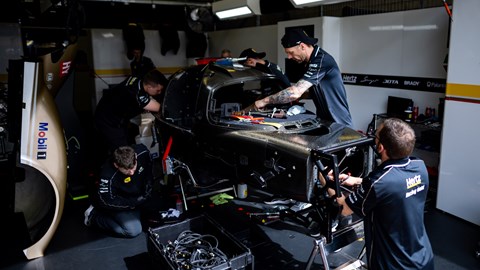
02:00 Thurs: Chassis irreparable
The crash looked gruesome, and although Illot was unscathed, his car was not. Most of the front of the #12 car was missing just minutes before the end of the session. It looked nasty, but endurance fans have been here many times: And unlike the delicate cars in F1, sports cars are known for their sturdy and modular construction. They can usually be fixed – whether it’s with a mallet, duct tape or a an entirely new piece of bodywork. Not so this time, though.
‘The damage to the chassis was on the lower wishbone. The rearward leg of the lower wishbone is held on to the chassis through the underneath by a bolt that goes into a metal insert,’ explains Hignett. ‘And where the wishbone hit the wall, it yanked that bolt out but had taken out the insert.’
This particular type of damage was significantly worse than the usual bodywork or suspension damage you usually see at Le Mans, and it couldn’t be cured by the miraculous bodywork and component changes we’re using to seeing at the Circuit de la Sarthe. By 2am Jota knew it’d have to find a new chassis.
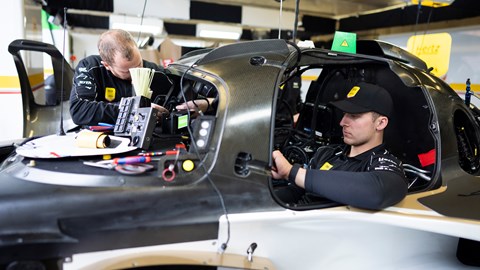
‘The chassis wasn’t cracked or anything like that, but that is not a field repair,’ continues Hignett. ‘It’s already back in the UK and being fixed. It needs have a patch made and to get put back in the autoclave.’
04:00 Thurs: Strategy meetings and car gets stripped
The process of ‘writing off’ the chassis involved more than Jota, with both the constructor Porsche and Multimac – the company that makes the chassis itself – having a look too. ‘Everybody’s working in harmony and you’re all in the garage at the same time, but everybody must have a look and see what they think about it.’
11:00 Thurs: replacement chassis arrives from Porsche, build starts
By 4am Porsche had secured a replacement chassis for its customer team, and it was on its way to France.
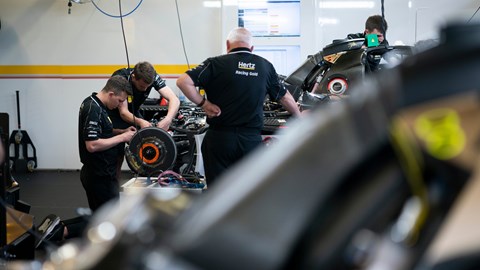
It took seven hours for the replacement chassis to appear, and in that time the Jota mechanics had worked flat out to salvage everything else from the outgoing chassis. It’s at this point that the race to rebuild the new car really began.
Amongst all the bad luck there was a bit of fortune – partly the result of Jota’s own forward planning: ‘We were very fortunate in that we came to the event quite organised,’ Hignett reveals. ‘We had a complete rear end for Le Mans that we had run for 300 kilometres of Paul Ricard, and then taken off and put in the truck.’
‘Engine backwards, we had already assembled so the bulk of the work was in building up the chassis. It didn’t have any rockers in it, a steering system or anything like that. No wiring looms. All of that had to be done.’

13:00 Fri: Car gets fired up
The process for such a task usually takes weeks instead of hours, but Jota’s team of mechanics were forced to move much, much faster. It’d have been a tricky task in Le Mans of old, but Jota’s engineers were also forced to deal with the huge amount of tech in today’s hypercars.
‘These cars are immensely complicated, huge numbers of computers and technology within it and it’s making all those systems talk to each other and communicate and work together,’ Hignett tells us. ‘There’s like a debugging session where you have to run through everything and check it all works because there were some different wiring looms and things like that.’
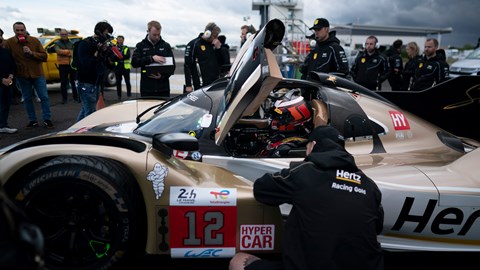
At 1pm, just one hour after the deadline Jota was able to fire up the Porsche 963’s powertrain for the first time.
20:00 Fri: Runway shakedown
‘First of all, you have to get approval from the stewards because you’re running when other people aren’t running, and then you have to get the runway on board,’ Hignett tells us. This is surely the most visually striking part of the story, and it took place not on the track, but parallel to the start finish straight on a private runway. With the track being used throughout the week, the runway was the best place for Jota to shakedown its recently rebuilt car.
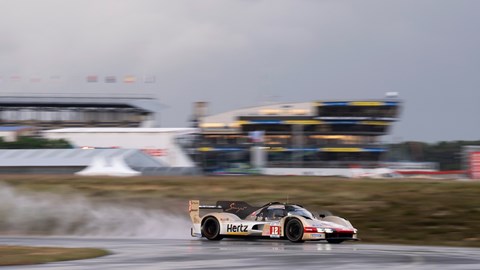
The footage will go down in Le Mans lore: private jets sat parked in the background, while the 963 zoomed back and forth in the rain, rooster tail following immediately behind. Engineers with laptops stand in the rain, with slightly apprehensive expressions.
‘I don’t think it’s been done for a few years but we’re not the first people to have ever done it,’ Hignett tells us matter-of-factly. ‘All you can do in that situation is check the thing changes gear, and all the systems work as far as you can tell. ‘
02:00 Sat: Fixing gremlins
A couple of gremlins after that bit needed work, so there was a late-night last night as well for a few of the guys and then out in warm up. The car was okay, and we made some adjustments for the race. It’s not perfect, but it’s running round and it’s somewhere in the top six. So yeah, it’s okay.
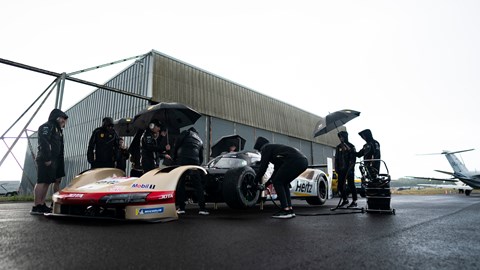
16:00 Sat: Race start
16:00 Sun: Race end
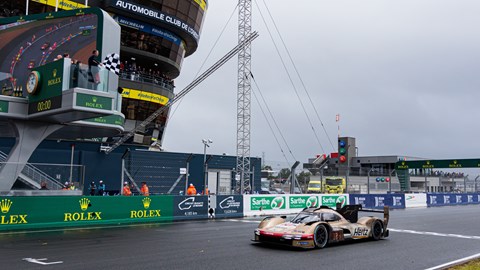
Fast-forward a few hours, and the #12 car finished a respectable P8. It could’ve been better, but the last minute rebuild meant the team was unable to truly bed in the car and finesse the setup to the usual degree.
Still, taking the chequered flag was a victory in itself for the privateer team, and the #12 car has already become just another part of the magic of Le Mans.